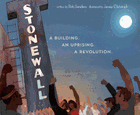
Two side-by-side 1840s stable houses in New York City's Greenwich Village initially boarded "the horses of the affluent." In the century-plus since, the neighborhood welcomed immigrants from around the world, and matured into "the creative center of New York City." In 1930, the double buildings merged to become Bonnie's Stone Wall restaurant. By the 1960s, the Village was "home for people who were told that they didn't fit in or belong," especially gays and lesbians. In 1967, the renamed Stonewall Inn welcomed all.
"Others were not as accepting. They thought those who gathered within our walls were too different," the buildings explain, but the Inn "kept opening our doors." After years of quiet submission, a police raid on June 28, 1969, ignited "the spark of anger [that] grew into a smoldering resistance." The Stonewall Uprising signaled that a "new day was dawning for the gay rights movement." One year later, thousands proclaimed "Gay Liberation Day" in New York City. Every June since, the worldwide "LGBTQ+" celebration continues for this "movement that has come so far--a movement that still has further to go."
Rob Sanders, who previously documented LGBTQ+ history in Pride, chooses an ingenious perspective to tell the Stonewall story: the double buildings, acting together as plural narrator, allows for the inviting, inclusive use of "our" and "we," while their enduring existence becomes an emphatic statement about permanence. Artist Jamey Christoph (Gordon Parks) mirrors Sanders's description of the Village as "a place... where being different was welcomed and accepted" by presenting diversity across every page; his smallest details (like a trampled copy of New York City Gay Scene Guide) enhance accuracy. Additional backmatter--supplemental history, photographs, an interview with Uprising participant Martin Boyce--add further validity. These walls are talking: listen and learn. --Terry Hong, Smithsonian BookDragon

